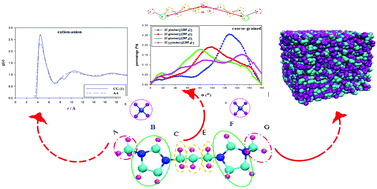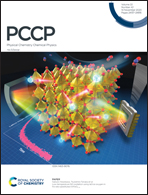Extension of transferable coarse-grained models to dicationic ionic liquids†
Abstract
In this study, we extended the previously developed coarse-grained (CG) models of mono-cationic ionic liquids (MILs) to di-cationic ILs (DILs). To achieve this purpose, the MD simulations in three different mapping schemes of CG were done and the results of RDF (as a structural property), density (as a volumetric property) and the diffusion coefficient (as a dynamical property) were compared with the corresponding results of the all-atom (AA) simulations for [C5(mim)2][BF4]2. The previously developed CG models for MILs with the least refinement in parameters were used to extend the CG models for DILs. Since, the first mapping scheme of the CG model showed the best agreement with the results of the AA simulations for the three mentioned studied properties, this scheme was selected to simulate DILs using the CG model. The transferability of the selected CG model to DILs was investigated by comparing the different volumetric, structural and dynamical properties of [Cn(mim)2][BF4]2 (with n = 3, 6, 9, and 12) obtained from the CG model with those obtained using the corresponding atomistic simulations at different thermodynamic state points. The average deviation for the densities of the CG model with respect to the AA results is less than 2%. Furthermore, in both CG and AA models, the densities and isobaric expansion coefficients decrease with increasing temperature and linkage alkyl chain. The structural properties of the studied DILs, i.e. RDFs, nano segregation of domains, heterogeneity order parameters (HOPs) and angle distributions showed good agreements between the results of the CG and AA models. The CG-based calculated diffusion coefficients of the studied DILs at different temperatures showed that this model leads to faster dynamics with respect to the AA model due to the sacrifice of some degrees of freedom in this model. However, the trend of increasing diffusion coefficients with increasing temperature and linkage alkyl chain length is the same in both CG and AA models. Also, there are good agreements between the results of these two models for other dynamical properties, i.e. electrical conductivity, transference numbers and non-Gaussian parameter with increasing linkage alkyl chain and at various temperatures.



 Please wait while we load your content...
Please wait while we load your content...